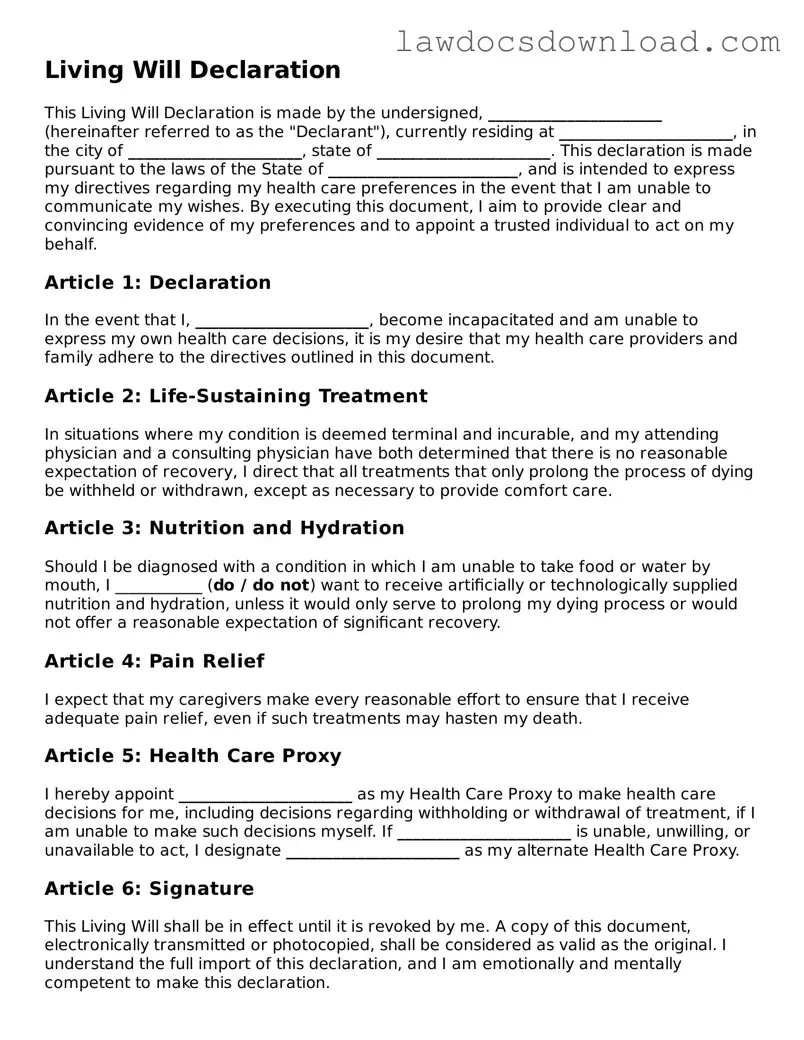Living Will Declaration
This Living Will Declaration is made by the undersigned, ______________________ (hereinafter referred to as the "Declarant"), currently residing at ______________________, in the city of ______________________, state of ______________________. This declaration is made pursuant to the laws of the State of ________________________, and is intended to express my directives regarding my health care preferences in the event that I am unable to communicate my wishes. By executing this document, I aim to provide clear and convincing evidence of my preferences and to appoint a trusted individual to act on my behalf.
Article 1: Declaration
In the event that I, ______________________, become incapacitated and am unable to express my own health care decisions, it is my desire that my health care providers and family adhere to the directives outlined in this document.
Article 2: Life-Sustaining Treatment
In situations where my condition is deemed terminal and incurable, and my attending physician and a consulting physician have both determined that there is no reasonable expectation of recovery, I direct that all treatments that only prolong the process of dying be withheld or withdrawn, except as necessary to provide comfort care.
Article 3: Nutrition and Hydration
Should I be diagnosed with a condition in which I am unable to take food or water by mouth, I ___________ (do / do not) want to receive artificially or technologically supplied nutrition and hydration, unless it would only serve to prolong my dying process or would not offer a reasonable expectation of significant recovery.
Article 4: Pain Relief
I expect that my caregivers make every reasonable effort to ensure that I receive adequate pain relief, even if such treatments may hasten my death.
Article 5: Health Care Proxy
I hereby appoint ______________________ as my Health Care Proxy to make health care decisions for me, including decisions regarding withholding or withdrawal of treatment, if I am unable to make such decisions myself. If ______________________ is unable, unwilling, or unavailable to act, I designate ______________________ as my alternate Health Care Proxy.
Article 6: Signature
This Living Will shall be in effect until it is revoked by me. A copy of this document, electronically transmitted or photocopied, shall be considered as valid as the original. I understand the full import of this declaration, and I am emotionally and mentally competent to make this declaration.
Executed this ____ day of ________________, 20____.
__________________________________
Signature of Declarant
__________________________________
Name of Declarant (Printed)
Article 7: Witnesses
State of ____________________
County of ____________________
I declare under penalty of perjury that the Declarant is personally known to me, that the Declarant signed or acknowledged this Living Will in my presence, that the Declarant appears to be of sound mind and under no duress, fraud, or undue influence, and that I am not the person appointed as Health Care Proxy by this document.
Witness 1 Signature: ________________________________
Name of Witness 1 (Printed): ________________________________
Witness 2 Signature: ________________________________
Name of Witness 2 (Printed): ________________________________
